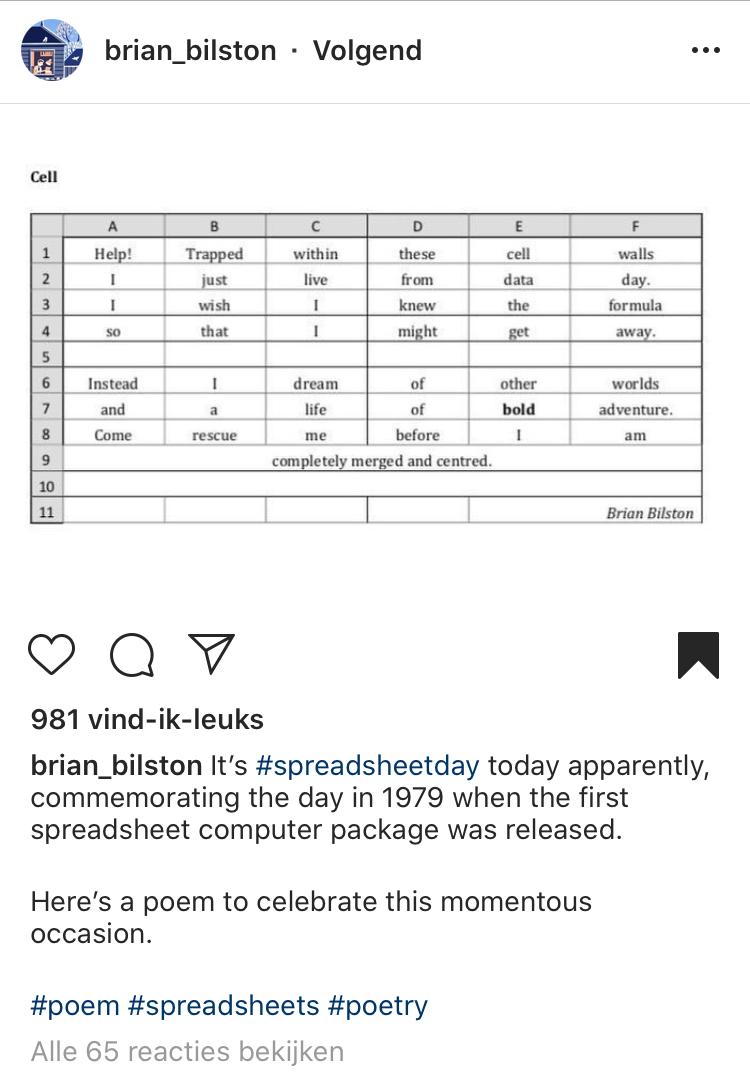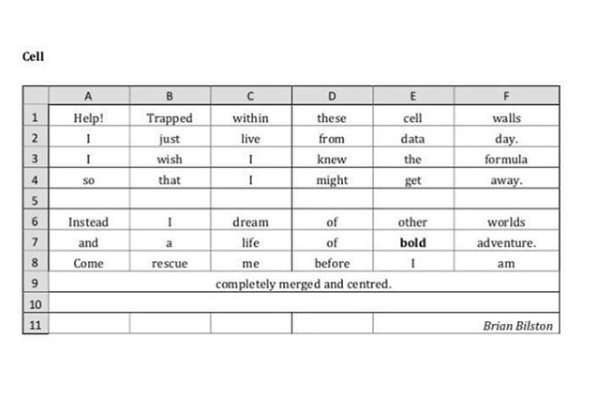
Analyzing Excel-poetry
Happy #spreadsheetday! On October 17th, 2018, Brian Bilston commemorated that this particular day in 1979, the first spreadsheet computer package was released. He posted a poem on his Instagram to "celebrate this momentous occasion". Excel-poetry was born

Brian Bilston, known as the ‘Banksy of poetry’, and previously as the ‘poet laureate of Twitter’, is someone whose words have peppered social media to the delight of poetry (and non-poetry) fans alike. His general rule of thumb is: “If I write something and it’s not amusing me, then I don’t think it has a chance of amusing anyone else either” (Ong, 2019). With that said, he simultaneously explained his chosen genre of poetry being light verse, meaning writing uplifting, innocent and feel-good poems (Van der Starre, 2019).
With over 281,000 followers, he is one of the best-kept secrets on Instagram. His themes range from actual poems about Brexit and gun laws in the United States, to pop-cultural poems about selfies and Game of Thrones, and identifiable poems about delaying on to do lists and the karma of Monday morning. This last theme is crucial for being seen as real #instapoetry, according to Kila van der Starre (2019).

Cell by Brian Bilston
In this particular poem, he uses an ABCB scheme but one that is free in a visual layout. Meaning that every word is placed in a cell, relevant for his reference to spreadsheets, except the last line where he talks about being merged and centered. Another fun reference to spreadsheets in this poem is the replacement of ‘day to day’ to data. An excellent joke about the content of most spreadsheets.
Interrelation of the linguistic and material code
What is interesting about this poem is the similarity between what you read (language) and what you see (visual material). When Brian talks about being bold, the word is in a bold version of the font, but while talking about being centered, the poem is aligned in the center. The whole poem is linguistically about being trapped by or in something and getting out, materially it is shown by placing all text in a spreadsheet.

Hashtags of Cell on Instagram
The hashtags used in the caption of the Instagram post define the genre of the poem. Brian labels this post as a poem and as poetry. Instead of thematizing this poem as #wayout #feelingtrapped, he chooses to only use #spreadsheet, thereby reaching a bigger but less specific audience. With the hashtags he does use, he connects with the community of poetry writers and fans, and everyone who wants to enter by just searching with a hashtag on Instagram or any platform (Van der Starre, 2019).
Part of the material code is as well the appreciation of followers. Within the 65 comments, there is a lot of picking up on the joke and praising.
However, there isn’t any interaction between Brian and followers after posting. He uses Instagram for feedback on his poems and self-promotion on poetry reading events, where he will cite his poems, launching events, and re-advertising of his book(s).
Layers of #instapoetry
A way to analyze and discuss #instapoetry is by four different layers of material code, designed by Kila van der Starre. Each layer has its own focus on different aspects of online poetry.
The first layer is the material code: the device. In many cases, this would be a mobile phone since that is the device we use the most, nowadays. While waiting for the train, a doctor’s appointment or even when you just woke up, we all use our phones as a tool to catch up on life or - maybe even more accurately - waste time.
Second is the app in which we view this poem. Obviously, this is Instagram, since we are analyzing #instapoetry. Brian’s bio on Instagram only states: “I write poems” and a link to where you can order his newest book. He has some highlighted stories, all being 60 or more weeks old. However, his oldest post is only 5 days old. Leaving us wondering if his ‘secret’ identity is withdrawing him from sharing anything personal and therefore is unable to commit to Instagram stories. His feed shows a standardized visual appearance. All poems are in the same font and the same colors, and use the same characteristics: a bold title, space underneath, followed by the poem and ending with another white space and signature in italic. Here and there the pattern of digital poems gets interrupted by actual photos. The photos contain captions informing us on meeting opportunities, book releases or some other form of self-promotion.
The third layer is the materiality of the poem itself. This one is traditionally set up like the others with a title in bold, an empty white space between paragraphs, and a signature in italic at the bottom right corner. What is surprising about this poem is that the words are the separated in the cells, and the exact distribution over the spreadsheet as a whole. The poet adheres to the rules of general spelling. Using dots and exclamation marks followed by a new sentence starting with a capital letter. There is none of the individuality or authenticity other #instapoets express by rejecting spelling rules. He distinguishes himself as a poet, since everyone else on Instagram, except for Brian, seems to be making up their own rules.
Last but not least is the fourth layer, the carrier of the poem. Features such as printed paper, reflection of light, ink, writing or paint to make it visually more attractive can indicate this fourth layer. In this particular case, there is no sign of ‘analogousness’ or physicality, and therefore there is no fourth layer.
Excel-poetry
All in all, Brian Bilston is an excellent poet with a small following on Instagram. His work can be classified as #instapoetry since his poems are smart, short and sweet (as is typical of the light verse genre). His posts are digitalized poems without any sign of the fourth layer of physicality. Here and there he breaks up his pattern of poems with an actual photo, using this as an opportunity to self-promote for marketing reasons, being a truly #instaworthy poet-entrepreneur (Hill, F., Yuan, K., 2018).
References
Ong, J. (June 25, 2019). The poet laureate of Twitter Brian Bilston creates four new poems from Adobe Stock images. It’s nice that.
Van der Starre, K. (2019). 2012: Tim Hofman post voor het eerst een gedicht op Instagram, DW B 164.3, september 2019, p. 37-48.
Bilston, B. (n.d.) [instagram account].
Hill, F., Yuan, K. (October 15, 2018). How Instagram Saved Poetry. The Atlantic.